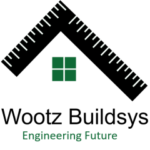
In today’s building world, Light Gauge Steel Frames (LGSF) are gaining popularity. They’re different from typical building stuff. LGSF are strong, flexible, and sustainable, making them a top pick for builders and designers globally. Wondering about this new build process? what they’re made of, how they’re made, their perks, and where they’re used.

What are Light Gauge Steel Frames (LGSF)?
Light Gauge Steel Frames are made from thin sheets of cold-formed steel, typically ranging from 1-3mm in thickness. These steel frames are fabricated by cold bending the steel sheets into various shapes, such as C-sections, Z-sections, and U-sections, to form a structural framework for buildings.
Composition of Light Gauge Steel Frames:
Light Gauge Steel Frames are composed of galvanized or coated steel sheets, which are corrosion-resistant and provide durability to the structure. The steel sheets are typically manufactured from recycled steel, making LGSF a sustainable construction option.
Manufacturing Process:
The manufacturing process of Light Gauge Steel Frames involves several steps:
a. Steel Coil: The process begins with uncoiling steel coils, which are then fed into the roll-forming machine.
b. Roll-Forming: The steel sheets pass through the roll-forming machine, where they are cold-bent into the desired shape, forming the sections of the frame.
c. Cutting and Punching: The sections are cut to the required lengths and punched with holes for easy assembly.
d. Galvanization or Coating: The sections are galvanized or coated to enhance their corrosion resistance.
e. Packaging: The finished sections are packaged and transported to the construction site for assembly.
Advantages of Light Gauge Steel Frames:
Strength and Durability: Light Gauge Steel Frames offer excellent structural strength, making them resistant to earthquakes, high winds, and other extreme weather conditions.
Lightweight: LGSF is lightweight compared to other construction materials, making it easier to transport, handle, and assemble.
Speed of Construction: The prefabricated nature of LGSF allows for faster construction, reducing project timelines.
Design Flexibility: LGSF offers design flexibility, enabling architects to create innovative and customized structures.
Sustainability: LGSF is an eco-friendly option, utilizing recycled steel and reducing construction waste.
Applications of Light Gauge Steel Frames:
Light Gauge Steel Frames have a wide range of applications in various sectors, including:
Residential Buildings: LGSF is used in the construction of single-family homes, multi-story apartments, and townhouses.
Commercial Buildings: LGSF is suitable for office buildings, retail spaces, hotels, and other commercial structures.
Educational Facilities: Schools, colleges, and universities can benefit from LGSF’s fast construction and design flexibility.
Healthcare Facilities: Hospitals, clinics, and medical centers can be constructed using LGSF to meet specific healthcare requirements.
Industrial Buildings: LGSF is used for warehouses, factories, and industrial structures due to its strength and durability.
Conclusion:
Light Gauge Steel Frames have revolutionized the construction industry with their strength, sustainability, and design flexibility. From residential buildings to commercial and industrial structures, LGSF offers numerous advantages for modern construction projects. Understanding the composition, manufacturing process, advantages, and applications of Light Gauge Steel Frames provides valuable insights into this innovative construction method, enabling architects, engineers, and developers to make informed decisions when considering LGSF for their projects.
Frequently Asked Questions FAQs
Q1: What are prefabricated structures?
Prefabricated structures are buildings or building components that are manufactured off-site in a controlled factory environment and then transported to the construction site for assembly. This construction method offers advantages such as faster construction, cost-efficiency, and improved quality control.
Q2: What is a Light Gauge Steel Frame (LGSF)?
Light Gauge Steel Frames (LGSF) are made from cold-formed steel sections and are used as the structural framework for prefabricated buildings. These frames are lightweight, durable, and resistant to corrosion, offering strength and stability to the structure.
Q3: What are the benefits of using LGSF in prefabricated structures?
Some key benefits of using LGSF in prefabricated structures include:
Speed of construction: LGSF structures can be erected quickly, reducing construction time.
Cost-effectiveness: LGSF systems optimize construction efficiency, resulting in cost savings.
Design flexibility: LGSF allows for customization and adaptability to meet specific architectural requirements.
Structural strength: LGSF frames offer high strength-to-weight ratio and durability.
Sustainability: LGSF construction reduces waste, utilizes recycled materials, and incorporates energy-efficient features.
Q4: Are prefabricated structures as durable as traditionally constructed buildings?
A4: Yes, prefabricated structures, including those with LGSF frames, can be designed to be highly durable. The use of steel frames provides structural integrity and resistance to natural disasters such as earthquakes and high winds. Proper design, engineering, and quality control ensure the longevity and durability of prefabricated structures.


